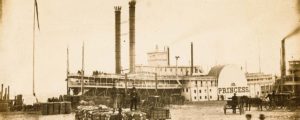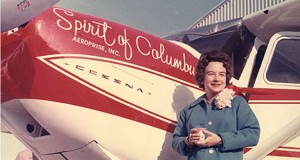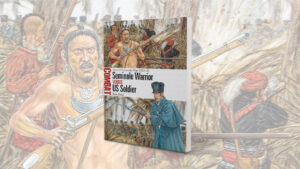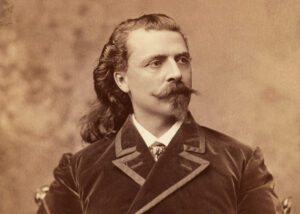A collection of peace tokens given to American Indians sets a whopping new record at auction.
In the field of American numismatics, collector and dealer John J. Ford Jr. was in a class by himself. By the time he died at age 81 on June 7, 2005, his career had become the stuff of legend. The first 15 of some 20 auctions required to liquidate his vast collections of colonial coins, historical medals, slave-hire tags and paper money realized more than $45 million.
Ford’s collection of Indian peace medals was particularly impressive, and many of them are thought to be the finest known examples of their type. Michael Hodder, creator of the catalog for the sales held in New York by Stack’s Rare Coins, said that Ford “lavished more study and spent more money on peace medals than on anything else he collected.” The practice of presenting die-struck medals as diplomatic gifts to American Indians began with the Spanish explorers. Later, Spanish, French and English governments substituted medals for coins and made an elaborate ritual of presenting them to chiefs deemed important to the maintenance of peaceful relations. By the middle of the 18th century, the practice of striking medals specifically for presentation to chiefs was well established. European-struck peace medals typically featured a portrait of the current ruling monarch on the obverse (front) and either the national arms or a peaceful scene or symbols on the reverse (back).
A prominent Philadelphia Quaker group, the Friendly Association for Regaining and Preserving Peace With the Indians by Pacific Measures, issued the first peace medal to be struck in North America in 1757, during the French and Indian War. Its members knew something had to be done to stop the increasingly vicious Delaware and Shawnee attacks on Ohio Valley settlers, but believed that military actions planned by Pennsylvania’s colonial government would only provoke more tribes to join France in its bid to drive the British from the area.
Declaring its intention to deal diplomatically with the Indians, the Friendly Association raised 20,000 pounds in subscriptions over its seven-year existence. The funds were to be spent on peace missions to tribes across the colony, which included offerings in the form of medals, looking glasses, sewing needles, fabric, finished clothing and other useful articles. Clockmaker Edward Duffield engraved the dies for the silver medals. Since the colonies had no coining presses at the time, Philadelphia silversmith Joseph Richardson had to strike the impressions with a sledgehammer in the manner of ancient coiners.
After the British captured Montreal in 1760, French competition for influence with the Indians was ended. Rather than attempt to forge treaties with the tribes who had supported France, the British elected to deny them the right to trade for goods or ammunition at British forts and discontinued the annual practice of making large ceremonial gifts. The new policies created seething discontent, and in the spring of 1763, a charismatic Ottawa chief named Pontiac organized a widespread revolt, destroying eight of 10 military forts west of the Alleghenies. Sir William Johnson, the longtime superintendent of Indian affairs who had advised against the harsh policies, invited Pontiac and other influential chiefs to peace councils at Forts Niagara and Oswego in 1764 and 1766, where he distributed “Happy While United” peace medals cast by New York silversmith Daniel Christian Fueter.
The official U.S. program of issuing peace medals for each sitting president got underway in 1789 with large, oval-format medals created by silversmith Richardson. These pieces were hand engraved on silver sheets placed back to back and sealed together with a rim. While no two were alike, most bore an engraving of George Washington and an Indian brave standing together, sharing a peace pipe.
The elegant 1801 medals of Thomas Jefferson’s administration launched the U.S. Mint series of presidential peace medals, which continued through the 19th century. Jefferson, who often concerned himself with the symbolism used on official items, must have been greatly pleased with engraver John Reich’s classic reverse design for his medal: a simple but warm image of a handshake. Subsequent presidents retained this reverse on all peace medals struck through 1850.
After the War of 1812, the use of peace medal diplomacy increased considerably. The U.S. Indian agents operating in Michigan, Illinois and Indiana territories saw a particular benefit in replacing the peace medals that had been handed out so liberally by the British during the war. The agents negotiated the exchange of American medals for all British medals, in hopes of developing unanimous tribal loyalty to U.S. interests. Many medals bearing President James Madison’s image went toward this effort.
Salathiel Ellis, a New York City cameo cutter, and his protégé Joseph Willson became the Mint’s peace medal design team in 1850, creating medals for Millard Fillmore, Franklin Pierce, James Buchanan and Abraham Lincoln. For the Fillmore and Pierce medals, the pair departed from the handshake reverse design in favor of a scene with an Indian and a settler facing each other in front of the American flag. This device retained the usual symmetry seen on peace medals, showing the two hand in hand or eye to eye, occupying equal amounts of space within the circular field. The motifs they conceived in 1857 for the Buchanan and Lincoln medals, however, departed radically from that format. According to art historian Klaus Lubbers, the placement of Indian images on the outer ring of the medal’s field reflected their changing role in the political life of the nation. Literally and figuratively, Indians were being pushed to the outside, their customs and traditions marginalized along with their power.
After 1876, when the U.S. government ordered the removal of the majority of Indians to reservations or reserves, the awarding of peace medals tapered off and came to serve more as an inducement to good behavior than as a tool of détente. By the 1880s, so few medals were needed that the government decided the pieces struck for President Benjamin Harrison in 1890 would be the last.
As anticipated, the John Ford peace medal collection auctioned on October 17, 2006, brought a record-setting return, topping $3.32 million for 189 lots, bettering by far any previous medal auction in the world. Most pieces received multiple bids; many winning bids reached five figures, and six-figure bids were not uncommon.
To lovers of historical medals, the dollar amounts realized take second place to the attention bestowed on the objects on the world stage. The detailed and scrupulously researched sale catalogs also become records of material culture: in this case, European and American relations with the native empires of the New World.
Originally published in the August 2007 issue of American History. To subscribe, click here.




